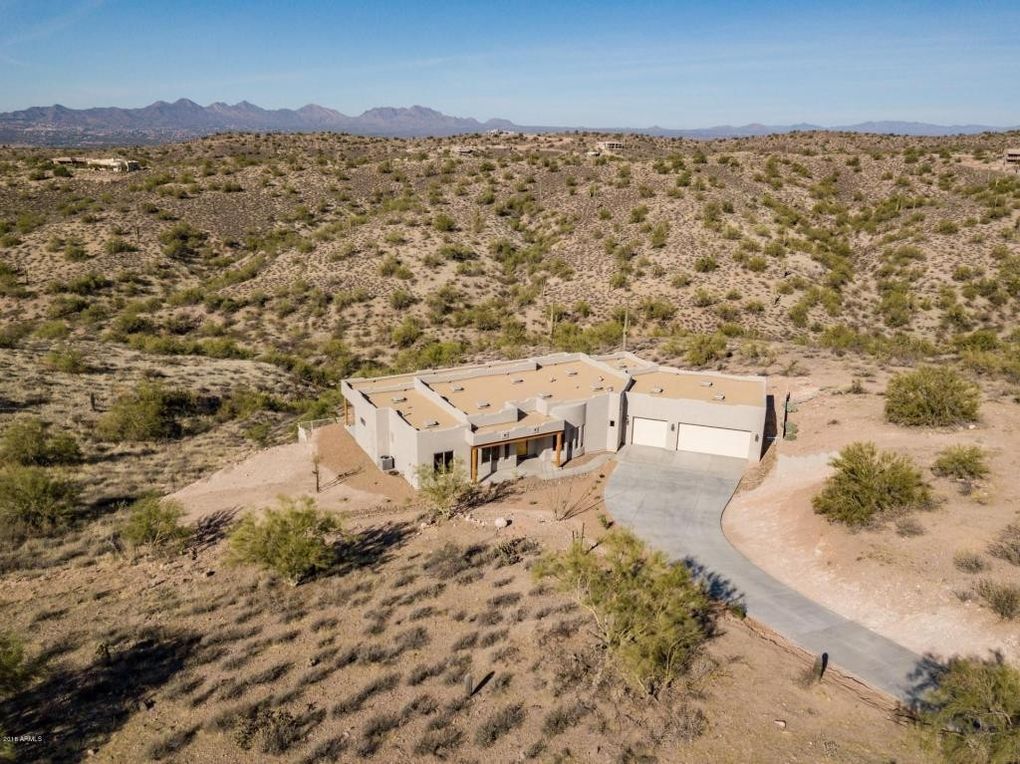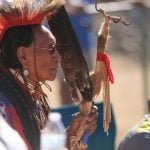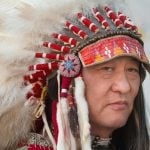The Creation of the Fort McDowell Reservation

When the Yavapai came under the jurisdiction of the United States following the acquisition of what was to become Arizona, they were a loose association of locally organized groups speaking mutually intelligible but nevertheless distinct sub-dialects. Traditional Yavapai territory stretched from the San Francisco Peaks in the north, to the Pinal Mountains in the east, and to the confluence of the Gila and Colorado Rivers in the southwest. Following the discovery of gold in Yavapai territory in 1863, the American government and the Americans who settled in Yavapai territory began plotting the removal of the Yavapai from their traditional territory.
The Colorado River Indian Reservation was established in 1865 by an act of Congress. While the reservation was initially settled by the Chemehuevi and Mohave, many Americans viewed this as a potential home for the Yavapai as well. Soon after the creation of the reservation about 800 Yavapai under the leadership of Quashackama settled on the Colorado River Indian Reservation. Quashackama was given papers attesting to the peaceful intentions of the Yavapai and an American farmer was appointed to help them with their planting. However, the land on which they were settled was land that none of the Americans wanted because the soil was sandy and alkaline and thus difficult, if not impossible, to farm.
Two years later, the number of Yavapai attempting to live on the Colorado Indian Reservation had dwindled to about 300. Under the leadership of Quashackama, Ohatchecama, Chawmasecha, Hochachiwaca, and Quacanthewya they were living on some beef, flour, and corn which they received from the federal government. They supplemented this by gathering mesquite beans in the late summer and harvesting whatever crops they were able to grow. Some did occasional wage work, including prostitution.
In 1867, a group of about 50 Kwevkepaya Yavapai under the leadership of Delshe visited Camp Miller. The army commander of Camp Miller was building a road deep into the Tonto Basin region of Yavapai territory. In discussions with the commander, the Yavapai agreed to take up farming along Tonto Creek once the road was completed.
In 1871, Yavapai leaders Delshe and Eschetlepan met with an army officer to discuss peace. Delshe requested a reservation in the Yavapai homeland, close to the mountain resources which his people exploited, and far from their traditional enemies, the Pima and Maricopa.
At this time, Vincent Coyler, a member of the U.S. Board of Indian Commissioners, visited with the Yavapai and Tonto Apache for the purpose of establishing a reservation for them. Unfortunately, Coyler did not understand that the Yavapai and the Tonto Apache were distinct peoples. In addition, he failed to realize that there were four distinct bands of Yavapai. He envisioned the creation of a single reservation for all of these groups and selected the Verde Valley as the best site for the reservation. While the leaders from the Yavapé and Wipukepa Yavapai bands convinced him that this would be a good location, he never actually talked with the leaders of the Kwevkepaya Yavapai and Tonto Apache bands.
Following Coyler’s recommendations, Fort McDowell and Camp Date Creek were established as temporary asylums for the Yavapai where they would be fed, protected, and cared for by the army. Nearly 600 Yavapai received food and handouts and the army reported that American travelers in the area were now safe. Conditions on the new reservation, however, were less than desirable for the Yavapai: food rations provided too few calories, and U.S. officers treated some Yavapai men to leg irons or confinement in the guardhouse.
In 1871, the Rio Verde Reservation was established for the Yavapai. The army ordered that all “roving Apache” (the army thought that the Yavapai were an Apache group) be on this reservation or be considered hostile. The following year, reservation life for the Yavapai on the Rio Verde Reservation became stricter with the arrival of a new Indian agent. The Indians were now required to attend muster once a day and none of the Indians were allowed to leave the reservation without his written permission. Men on the reservation were required to wear metal tags identifying them by assigned numbers. Men who violated reservation rules were sent to the guard house: some were sentenced to a month of hard labor and some were forced to wear a ball and chain.
A delegation of Indians from Arizona-Yavapai, Pima, Apache, and Tohono O’odham-travelled in 1872 to Washington, D.C. and met with President Ulysses S. Grant. At the White House, each of the delegates received $50, a document which proclaimed him to be a “chief”, and a medal with Grant’s likeness. The Yavapai members of the delegation-Pakota (later called José Coffee) and Takodawa (later called Washington Charley)-were neither leaders nor headmen: they were simply two men who volunteered to go to Washington.
Grant expressed a desire for peace throughout the land. He told the delegates that if their people remained on their reservations and became full-time farmers, they would receive rations and education and they would have no further troubles with the army. While the Indian leaders who were listening to Grant desired peace, the greed and rabid ethnocentrism of Indian-hating citizens of Arizona would make this almost impossible.
.
In 1873, the Yavapai who were living in the Date Creek area were informed that they were to be moved to the Rio Verde Reservation. The move was being made without their consent. Chawmasecha, who had been an advocate of reservation life, refused to leave the familiar region. He led 240 Tolkepaya Yavapai west to the Colorado River Indian Reservation. While General O.O. Howard had said that the Yavapai could settle on the Colorado River Indian Reservation, General George Crook ordered them to be removed. U.S. Troops along with Pai scouts marched them back to the Rio Verde Reservation.
In 1873, an army surgeon on the Rio Verde Reservation doled out his entire supply of quinine to the sick Yavapai. When a new supply arrived, the Yavapai besieged the doctor for more as it had proved to be effective. This new medicine did not compete with older Yavapai healing practices. The medicine men (basemachas) would chant and dance over their ailing patients and then administer quinine and other drugs which they had obtained from the doctor (who was often in attendance). The army surgeon, Dr. Corbusier, was accepted by the basemachas as a fellow healer and was often presented with gifts of gratitude and invited to sit among them at ceremonials.
In 1874, the Office of Indian Affairs decided to close the Rio Verde Reservation and to move the Yavapai and Tonto Apache about 200 miles southeast to the San Carlos Apache Reservation. By eliminating this reservation, the Office of Indian Affairs would be able to open up the land to non-Indian settlement. Not only would the Americans be able to have the land, but they would also benefit from the irrigation system which had been put in for the Indians. At this time, the Indians on the reservation were well on their way to agricultural self-sufficiency and to being able to produce a surplus to sell.
The decision to move the Yavapai and Tonto Apache came about through the lobbying of government contractors. A self-sufficient, honestly administered reservation would mean a significant loss of business for them. On the San Carlos Reservation, a hotter and drier area with unfavorable farming conditions, the Indians would have to continue to receive government rations supplied, of course, by the government contractors.
Prior to their removal, the Yavapai and Tonto Apache headmen met with the special commissioner sent by the Indian Office to supervise the move. They explained the reasons why they did not want to go to San Carlos, but the special commissioner was drunk and often incoherent. U.S. officers, including the army surgeon, strongly suggested that the Indians be taken around the mountains by road so that wagons could be used to carry the elderly, the young, and the supplies. The special commissioner responded:
“They are Indians, let the beggars walk.”
In 1875, the Yavapai and the Tonto Apache were removed from the Rio Verde Reservation and forced to march some 200 miles through the mountains to the San Carlos Apache Reservation. In February, 1,476 Yavapai and Tonto Apache began their walk to San Carlos under military escort. They walked, climbed, crawled, and waded through the snow, mud, and streams of 180 miles of very cold and extremely rugged mountain ranges. They carried all their possessions on their backs and one man carried his wife in a large basket the entire way.
Twenty-five babies were born on the March of Tears and 1,361 Yavapai and Tonto Apache arrived at the San Carlos Reservation. This suggests that 140 did not complete the trip (taking into account the 25 babies born enroute). Some died along the way while others turned back, unwilling to face life in an unknown land.
Some Yavapai and Tonto Apache families stayed in the mountains to escape the March of Tears. However, army troops remained behind to hunt down the remaining Indian camps. A few miles east of Camp Verde, army scouts killed six Wipukepa Yavapai men and captured three women and seven children. Farther south, they killed four Tolkepaya Yavapai men and captured one woman and two children.
At the San Carlos Apache Reservation the Indian agent met with the newly arrived Yavapai and Tonto Apache and told them that they must surrender all of their arms. All of the Indians leapt to their feet and dashed back to their camps. However, the Indian agent refused to issue rations until the weapons were surrendered.
Shortly after arriving, a group of about 25 Tolkepaya Yavapai left the San Carlos Apache Reservation without permission and visited the Pima and Maricopa settlements. When they returned, they told the Indian agent that they had friends among the Pima and wanted to settle there. A little while later, a group of 27 Tolkepaya Yavapai left the reservation heading for the Pima settlements. This time the agent sent the Indian police after them. The Yavapai, even though they outnumbered the police, offered no resistance and were escorted back to the reservation.
In 1876, a small band of Yavapai under the leadership of Miraha left the San Carlos Apache Reservation without permission. They walked back across the Tonto Basin, passing north of the upper Verde Valley, and set up their camp just west of the Bill Williams Mountain. This high plateau area had traditionally been an unoccupied buffer between the Yavapai territory and Pai territory. The Yavapai set up their uwas (wickiups) and began to reestablish something of a pre-conquest lifestyle. From the American viewpoint, the Yavapai who left the reservation were considered hostile and in rebellion against the United States. Even though they may have had non-violent intentions, they were to be shot on sight. If possible, women and children were to be taken alive.
In 1877, the army’s Tonto Apache scouts captured a Yavapai woman and child. Her husband soon surrendered at Camp Verde. Using this prisoner as a guide, the army was able to locate Miraha’s Yavapai camp near the Bill Williams Mountain. Without offering the option of surrender, the army attacked the camp, killing seven men and taking three women and four children as prisoners. Five uwas (wickiups) were destroyed. The prisoners were marched back to the San Carlos Reservation.
In 1877, an Indian Office inspector reported that the tensions between the Tolkepaya Yavapai and the Apache on the San Carlos Reservation were disturbing the general harmony of the reservation. Yavapai spokesmen told the inspector that they would like to leave the reservation and were willing to live among the Pima or on the Colorado River Reservation. The inspector recommended that the Yavapai be allowed to leave.
By 1878, a number of Yavapai who had left the San Carlos Apache Reservation without permission had returned to their traditional territory and were living near Wickenburg where American residents employed them for farm work and domestic tasks. Takodawa (also known as Washington Charley as a result of his 1872 trip to visit President Ulysses S. Grant in Washington, D.C.) confronted a Tolkepaya Yavapai woman in the Wickenburg house where she was working. When she refused to leave with him, he then declared that “his heart has gone bad” and left, supposedly to incite other Yavapai in nearby camps. The residents of Wickenberg, fearing the worst, then detained the seven local Yavapai and requested troops be sent from Camp Verde. As a result, 17 more Yavapai were rounded up and taken back to San Carlos.
In 1885, U.S. Army officers took over the management of the San Carlos Reservation and used their powers to interfere with traditional Apache and Yavapai healing practices. The officers felt that the traditional beliefs and practices regarding healing were ignorant and dangerous.
Two years later, the Yavapai leaders on the San Carlos Reservation were able to meet with General Nelson Miles who had been called to the reservation to investigate a recent religious uprising. The Yavapai told Miles that they wanted a reservation in their old homelands. Miles instructed the Yavapai leaders to tour their old homelands and then to meet with him in Los Angeles. While General Miles did not have the authority to relocate the Yavapai on the traditional lands, his recommendations for this action brought sympathetic attention from federal officials.
When the American settlers living near Camp Verde heard that General Nelson Miles was recommending that the Yavapai be returned to a reservation on their old homelands, they sent a flurry of letters and petitions to the Secretary of the Interior, President Grover Cleveland, and other government officials. In their petition to the President, they asked for protection against the Indians and stated:
“Their only ambition is to murder, steal, and plunder.”
The President replied that he was sympathetic to their cause and would not allow the Yavapai to return home.
In 1901, Camp McDowell, an abandoned military reservation, was set aside for Indian use by Executive Order of President Theodore Roosevelt. Congress, however, rejected a bill that would create a Yavapai reservation because American squatters in the area objected.
In 1903, President Theodore Roosevelt sent his personal agent to investigate the situation of the Yavapai in the Verde Valley. The agent reported that there were more than 500 Yavapai living in the area. The agent recommended buying the squatters’ claims to Fort McDowell lands and this land be made available to the Yavapai. One concern expressed by the agent was that the Yavapai who lived close to the American communities would be demoralized by the gambling and drinking saloons. On the other hand, many of the Americans in the area argued that their children’s morals would be corrupted by having the Yavapai in the area.
In 1903, the Fort McDowell Reservation was created for the Yavapai by executive order of President Theodore Roosevelt. Under the order, all lands which were not legally claimed by Americans were to be turned over to the Yavapai who were living in the area. This action represented the culmination of four decades of efforts by the Yavapai to obtain a reservation in their homelands.



